20 Types of Melons (with Pictures)
-
Pete Ortiz
- Last updated:
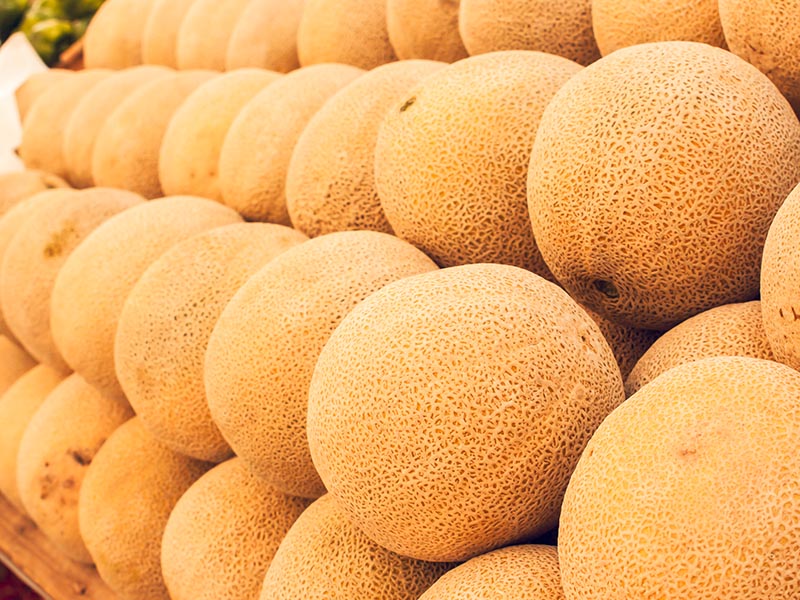
Melons are many people’s favorite dessert during summer. Some people may not be aware that there are countless varieties of melons, some of which you can easily find in stores, and some that are fairly rare. Each type has unique characteristics and a unique taste, and to find out the most popular varieties read the article below. We have listed the most interesting varieties that are adored and used worldwide.
The 20 Types of Melons
1. Watermelon
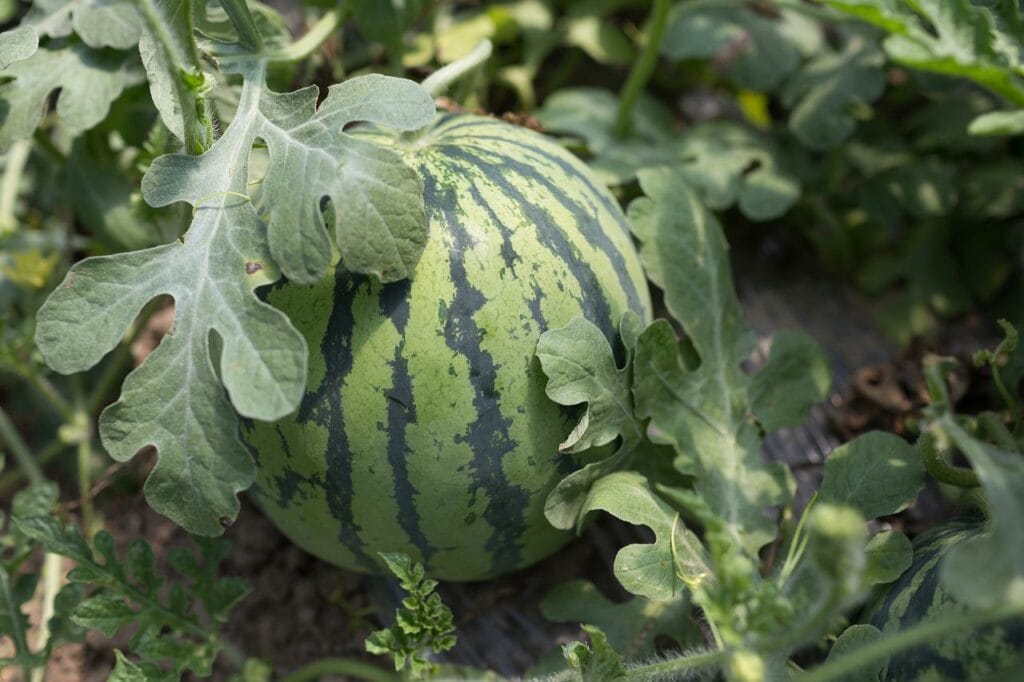
| Scientific name: | Citrullus lanatus |
| Origin: | Africa |
| Characteristics: | Pink, extremely sweet flesh |
| Uses: | Eaten raw, in fruit salads, and as juice |
Watermelons are one of the most common fruity desserts during summer. They are adored worldwide for their sweetness and refreshing taste. Healthy watermelons ready for consumption must have a deep green surface and, once tapped, will have a hollow sound.
2. Cantaloupe
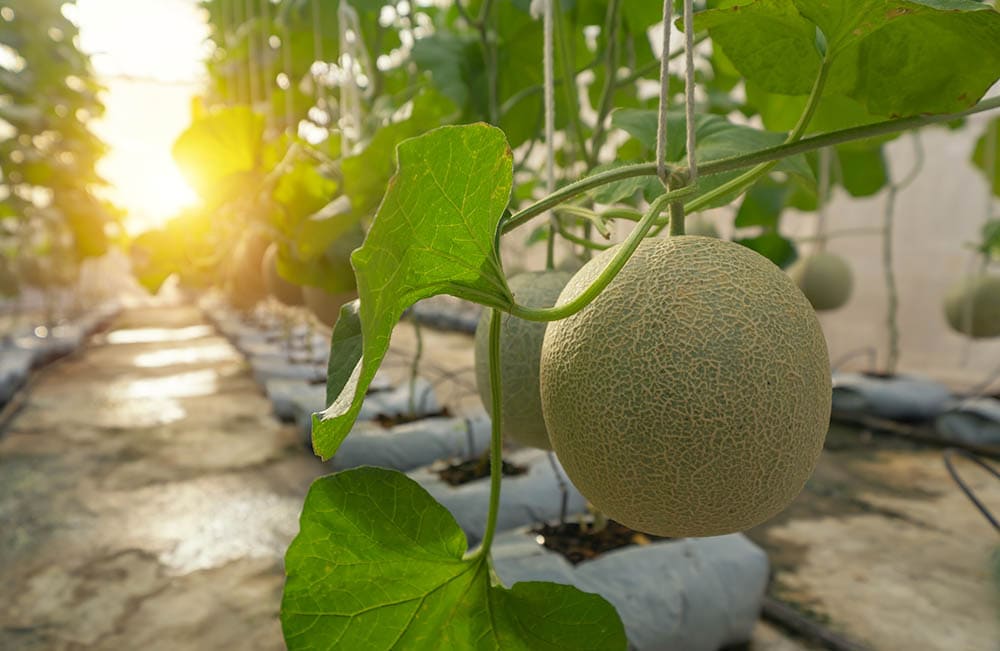
| Scientific name: | Cucumis melo var. cantalupensis |
| Origin: | The Middle East and India |
| Characteristics: | Firm orange flesh with a sweet but tender taste |
| Uses: | Eaten raw, in salads, cocktails, or sorbet |
Cantaloupe is another common favorite refreshment during hot days, consumed in various shapes and recipes. These unique fruits have a firm, creamy texture and are not as watery as watermelons. The healthiest cantaloupes will have a tan color with soft green lines.
3. Honeydew Melon

| Scientific name: | Cucumis melo L. ‘Honey Dew’ |
| Origin: | Middle East |
| Characteristics: | Pale green flesh with an extremely sweet taste |
| Uses: | Eaten raw, in fruit salads, in frozen yogurts, smoothies, cocktails |
Honeydews are some of the sweetest melons on the market, available from June through October. This fruit is excellent in combination with different salads, smoothies, and cocktails. Look for a Honeydew melon with a creamy yellow color and a smooth surface.
4. Bitter Melon
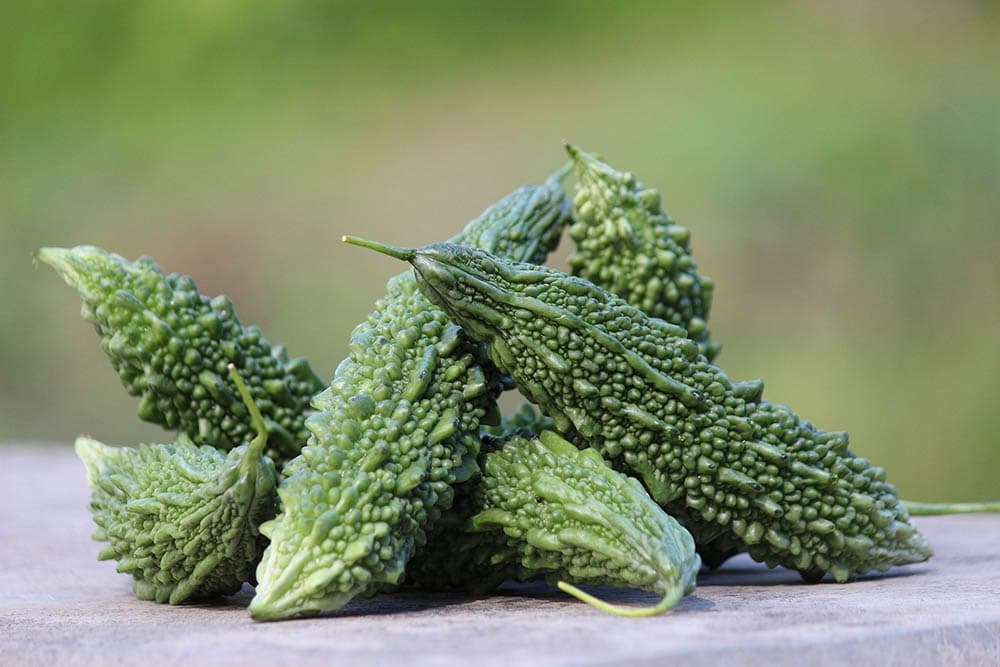
| Scientific name: | Momordica charantia |
| Origin: | Asia and Africa |
| Characteristics: | Watery, crunchy, and extremely bitter |
| Uses: | Raw or cooked in dishes |
Bitter melons carry a name that explains their prominent feature best. Due to their bitter flavor, they are mainly used as a vegetable or paired with other, sweeter fruits. Besides being used in various meals and dishes, this fruit has incredible immunity-boosting qualities.
5. Winter Melon

| Scientific name: | Benincasa hispida |
| Origin: | South Asia |
| Characteristics: | Thick white flesh with a mild taste |
| Uses: | Cooked in stews, soups, and stir-fried dishes |
Winter melons are another example of melons that lack recognizable sweetness and instead carry a mild aroma. These melons are mainly used as vegetables, cooked with stir-fries, soups, and chicken. It has incredible health benefits, such as improving digestion and boosting energy.
6. Korean Melon

| Scientific name: | Cucumis melo var. Makuwa |
| Origin: | Korea |
| Characteristics: | White crunchy flesh, sweet |
| Uses: | Raw or cooked |
The Korean melon is a fruit with excellent health benefits, especially for cardiovascular conditions, because of its low sodium and high potassium levels. It originates from East Asian countries, hence the name.
7. Canary Melon

| Scientific name: | Cucumis melo L. ‘Canary’ |
| Origin: | Asia |
| Characteristics: | Soft, pale-green flesh with a sweet flavor |
| Uses: | Eaten raw, and in fruit salads |
Canary melons have an easily recognizable bright yellow surface with a smooth surface. They have an extremely sweet taste making them an adored dessert across Asia and South America and popular even for breakfasts. Unlike their appearance and mealy flesh, they are a fruit with low calories and fat levels, with high fiber and vitamin content.
8. Ambrosia Melon
| Scientific name: | Cucumis melo ‘Ambrosia’ |
| Origin: | Western Asia |
| Characteristics: | Very sweet |
| Uses: | Eaten raw as a dessert or cooked with meats and cheeses |
The Ambrosia melon is quite similar to a common Cantaloupe, although it has a much sweeter taste. Because of its unique sweetness, it is most commonly used in fruit salads and desserts. However, it also pairs perfectly with salty meals, such as chicken and cheese.
9. Horned Melon

| Scientific name: | Cucumis metuliferus |
| Origin: | Africa |
| Characteristics: | Light green flesh, with a jelly-like texture and a slightly sweet but mild taste |
| Uses: | Eaten raw, in fruit salads, smoothies, or sundaes |
One entirely different-looking melon is the horned melon, also known as the Kiwano. This fruit has a cartoony and scary look, with horns growing on its entire surface. Unlike its appearance, the taste of a ripe horned melon is quite similar to a banana, and when not ripe, it will taste like a cucumber.
10. Crenshaw Melon
| Scientific name: | Casaba x Persian |
| Origin: | Turkey |
| Characteristics: | A cross cultivar of Casaba and Persian melons; sweet orange flesh |
| Uses: | Eaten raw as fruit dessert, in salads, smoothies, and sorbet |
Although the Crenshaw melon is a hybrid of the Casaba and Persian melon, it combines some of the best features of both varieties. The fruit is tender and juicy, with a lovely sweet taste, making it excellent to consume raw. It can also be a perfect addition to cocktails, fruit salads, and smoothies.
11. Persian Melon
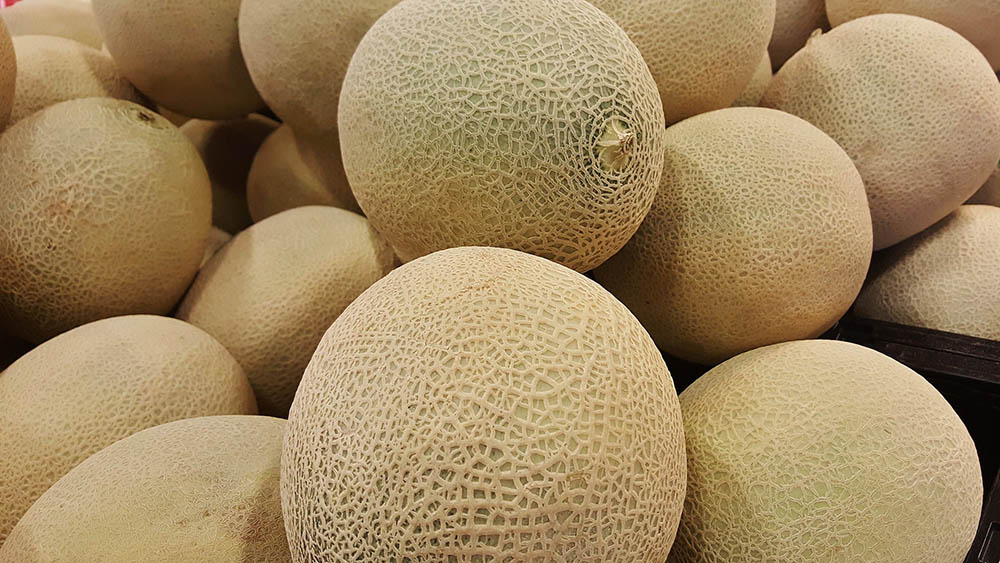
| Scientific name: | Cucumis melo |
| Origin: | The Persian Empire, Iran |
| Characteristics: | Similar to a cantaloupe but larger and with a milder flavor |
| Uses: | Eaten raw as a fruit |
The Persian melon carries a charming look with its elongated form and smooth yellow skin. While these melons may resemble Cantaloupes, they are much larger and have a milder flavor. These fruits carry excellent health benefits, such as being free of fat and cholesterol, with high levels of vitamins A and C.
12. Charentais Melon
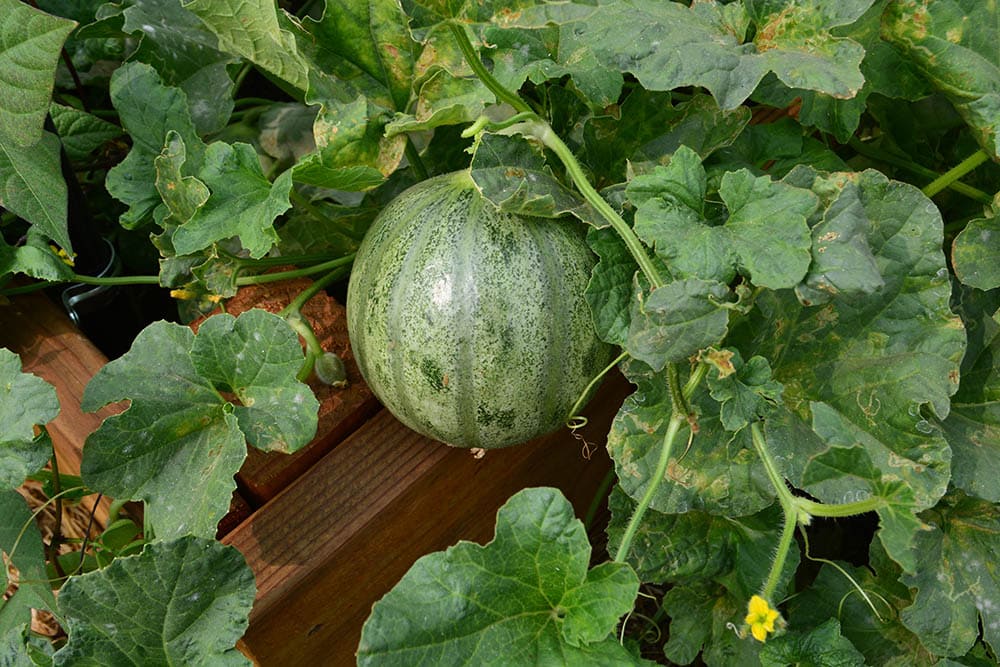
| Scientific name: | Cucumis melo var. cantalupensis |
| Origin: | France |
| Characteristics: | Bright orange flesh, with intense flavor and aroma |
| Uses: | Eaten raw, alone or with ham, or served with wine |
The Charentais melon originates from France. However, it is mostly produced in North Africa. This fruit is unique for its intense fragrance and taste, making it used in many dishes with ham and other meats. In some regions of France, people consider it a specialty to drink wine straight from the Charentais melon.
13. Snap Melon
| Scientific name: | Cucumis melo momordica |
| Origin: | Asia |
| Characteristics: | Sour and bitter taste |
| Uses: | Best combined with other sweet melons, sweet fruit, or sugar |
Snap melons are excellent cultivars to grow since they are usually self-sufficient. They have a slightly sour and bitter taste, which is why they are best paired with other fruits, some sweeter melon varieties, or sugar.
14. Crane Melon
| Scientific name: | Cucumis melo |
| Origin: | Developed in California |
| Characteristics: | Cross-farming of Japanese, Ambrosia, and Persian melons, with a lovely taste |
| Uses: | Eaten raw in salads or cooked in various dishes |
The Crane melon is another cross cultivar produced by a mix of Japanese, Ambrosia, and Persian melons. This melon is considered quite rare due to its incredibly short shelf life. Its pale-yellow and dark green spotted skin is easy to recognize, with a smooth texture. Its delightfully sweet aroma makes it an excellent addition to fruit salads and various dishes.
15. Gac Melon

| Scientific name: | Momordica cochinchinensis |
| Origin: | Vietnam |
| Characteristics: | Vibrant red flesh, with a buttery and mild flavor |
| Uses: | Cooked in soups, stews, curries, or rice |
The Gac melon is an excellent example of how looks can deceive. This vibrant fruit has dramatic skin with tiny spikes on its entire surface, while the inner flesh has a bright red color. Despite its unique appearance, the taste of this melon is similar to an avocado, making it an excellent addition to cooked meals such as stews, soups, and curries.
16. Cucamelon
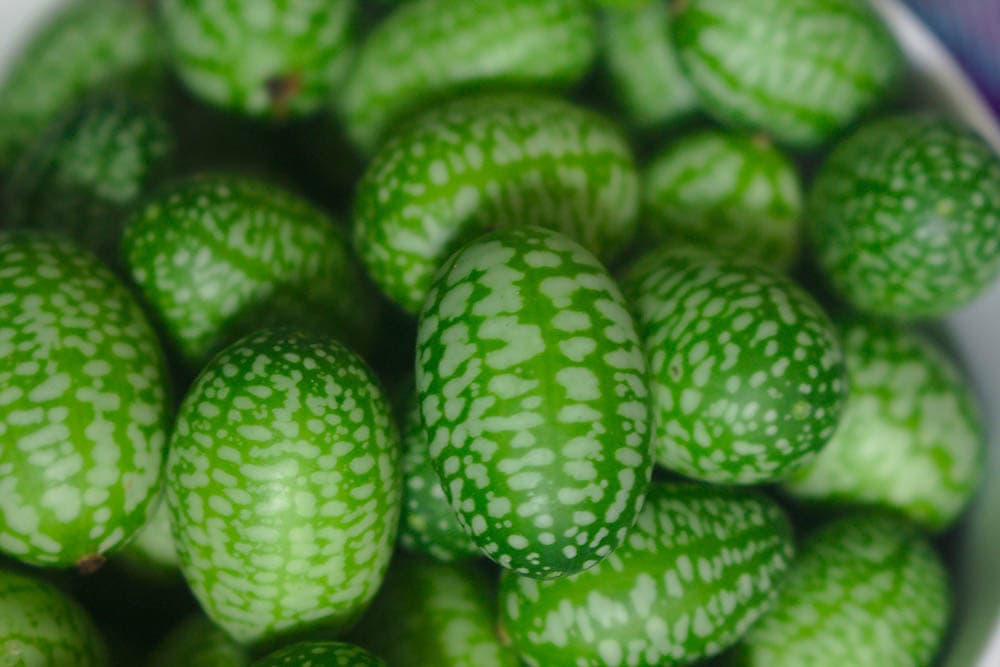
| Scientific name: | Melothria scabra |
| Origin: | Mexico and Central America |
| Characteristics: | Tiny, grape-sized, with a sour-sweet refreshing taste |
| Uses: | Eaten fresh, in salads, in cocktails, or cooked in stir-fries |
The Cucamelon is quite an interesting specimen of melons. These tiny fruits resemble and taste similarly to cucumbers, except they are the size of a grape. They have a sour, slightly sweet taste, making them excellent in cocktails and as garnish.
17. Kantola Melon

| Scientific name: | Momordica dioica |
| Origin: | South Asia |
| Characteristics: | Small, lemon-sized fruit with a mild and bitter flavor |
| Uses: | Eaten as a vegetable, fried or cooked with spices, fish, and meat |
The Kantola melon is a small lemon-sized fruit that, due to its bitter flavor, is mostly used as a vegetable. It is native to countries of South Asia, although exported internationally. Because of its mild aroma, it goes excellent when fried or cooked with meats and fish.
18. Galia Melon
| Scientific name: | Cucumis melo var. reticulatus |
| Origin: | Israel |
| Characteristics: | A cross between cantaloupe and honeydew, with a sweet and spicy taste |
| Uses: | Eaten fresh, as a dessert, with ice cream or sorbet |
Galia melons are another example of hybrid cultivars originating from Israel. They are round in shape and have an intense and sweet taste. The flesh is light green and white, with an aromatic flavor, making it one of the favorite fruits worldwide.
19. Casaba Melon
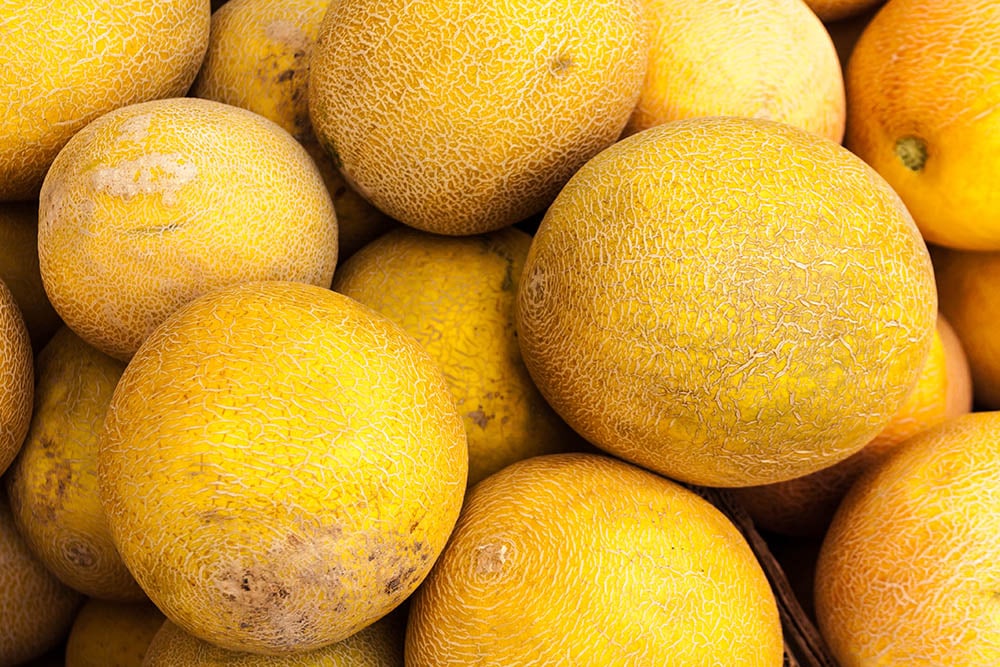
| Scientific name: | Cucumis melo var. Inodorus ‘Golden Casaba’ |
| Origin: | Persia, Asia Minor |
| Characteristics: | Sweetish, spicy |
| Uses: | Raw, sorbet, smoothies, curries |
The Casaba melon is unique since it resembles a pumpkin more than a melon. It was imported to the United States in the late 19th century from Kasaba, Turkey, which is how it got its name. Nevertheless, this melon originates from Asia Minor, particularly from Iran. They are sweet and spicy and are commonly used in smoothies, soups, and curries.
20. Citron Melon
| Scientific name: | Citrullus amarus |
| Origin: | Africa |
| Characteristics: | Hard white flesh, not sweet |
| Uses: | Pickled, cooked as preserves, inedible raw |
The Citron melon is quite similar, almost identical to the watermelon when observed. However, this melon cannot simply be eaten raw. Instead, it is mainly used cooked as a preserve or pickled.
Conclusion
Summer is incomplete without a taste of fresh, juicy melon during your day. The best part is there are so many varieties that you can constantly experiment with different flavors and dishes. While some melons may be too sweet and perfect as a fruit salad, others are bitter or sour, making them excellent for preparing salty dishes and specialties from around the world.
Featured Image Credit: Arina P Habich, Shutterstock
Contents


